
Roma Cast of Characters Campo dé Fiori Caffè San Pietro Colosseo Foro Romano Chiesa del Gesu Pantheon P. Navona S. Pietro Il Papa S. Eustachio S. Maria Trastevere Trastevere Bocca Verità Fontana di Trevi Museo Vaticani Villa Borghese Vittorie Mangia! Loose Ends Desktops
|
.
.
.
.
.
.
.
.
.
.
.
.
.
.
.
.
.
.
.
.
.
.
.
.
.
.
.
.
.
.
.
.
.
.
.
.
.
.
.
.
.
.
|
2000 Italia: Il Papa (The Pope)
We're visiting Roma during the Great Jubilee, the Holy Year. An aside to give you some context about the excitement felt by the thousands of pilgrims who are at San Pietro with us. Then we'll get to the pictures of Karol Wojtyla, His Holiness Ioannes Paulus PP. II, known in English as Pope John Paul II.
From the journal of the Central Committee for the Great Jubilee: In the Roman Catholic tradition, a holy year, or jubilee is a great religious event. It is a year of forgiveness of sins and also the punishment due to sin, it is a year of reconciliation between adversaries ... and consequently of solidarity, hope, justice, commitment to serve God with joy and in peace with our brothers and sisters. The origin of the Christian jubilee goes back to biblical times. The law of Moses prescribed a special year for the Jewish people: "You shall hallow the fiftieth year and proclaim the liberty throughout the land, to all its inhabitants; it shall be a jubilee for you when each of you shall return to your property and each of you shall return to your family. This fiftieth year is to be a jubilee year for you: you will not sow, you will not harvest the ungathered corn, you will not gather the untrimmed vine. The jubilee is to be a holy thing to you, you will eat what comes from the fields" (Leviticus 25:10-14). The trumpet with which this particular year was announced was a goat's horn called Yobel in Hebrew - the origin of the word jubilee. The celebration of this year also included the restitution of land to the original owners, the remission of debts, and the liberation of slaves; the land was left fallow for renewal.
 The first ordinary jubilee was proclaimed in a bull, Antiquorum Habet Fida Relatio, in 1300 by Pope Boniface VIII. Throughout Christendom there was great suffering; wars and diseases, such as the plague. There was a nostalgic desire to return to a more holy way of living. Christmas 1299 saw thousands of Christian pilgrims in Rome; they came to pray at the tombs Peter and Paul and to receive the Pope's blessing, to obtain the grace and strength to carry on. The Pope proclaimed a "year of forgiveness of all sins". A similar year would be held every hundred years. Participants of that first jubilee include Dante, Cima Bue, Giotto, and Carlo de Valois (the brother of the King of France) with his wife Catherine. Dante Alighiere writes of the event in his Divine Comedy in canto XXXI of Paradise.
While the apostolic see was transferred to Avignon in France (1305-1377) there were many requests for the second jubilee to be held earlier, in 1350 instead of 1400. Clement VI gave his consent and set a period of fifty years between jubilees. Besides visiting the basilicas built over the tombs of Peter and Paul the pilgrims were also required to visit to Saint John Lateran, the city's cathedral, the first church of the Bishop of Rome (the Pope).
Later Pope Urban VI decided to reduce the period to thirty three years in memory of the earthly life of Jesus. When Pope Urban died, however, the new Pope, Boniface IX opened the holy door on Christmas Eve 1390. The numbers of pilgrims were so great he called a second holy year at Christmas 1400.
In 1425, and not in 1433, as it had been formerly set, Pope Martin V proclaimed the holy year 1425 with two novelties: a special commemorative jubilee medal and the opening of a holy door in the cathedral of Saint John Lateran.
Nicholas V called the 1450 holy year and in 1470 Pope Paul II issued a bull to celebrate the jubilee every twenty-five years. The next holy year was proclaimed by Sixtus IV in 1475. For the occasion the Pope wished to adorn Rome with more works of art: he ordered the building of the Sistine Chapel and the Ponte Sisto (Sixtus Bridge) over the River Tiber (both named after him).
In 1500 Pope Alexander VI announced that the doors in the four major basilicas would be opened contemporaneously, and that he himself would open the holy door of Saint Peter's. The ninth jubilee was solemnly opened on 24 December 1524 by Pope Clement VII, at a time when there were already symptoms of the great crises which would soon tear the Church apart, at the time of the Reformation.
The 1550 jubilee was proclaimed by Paul II, but it was Pope Julius III who actually opened it. The remarkable number of pilgrims caused some difficulties in the city and Saint Philip Neri was among those who came to their help with his confraternity of the Holy Trinity.
It is recorded that in 1575, in the time of Pope Gregory XIII, as many as 300,000 people came to Rome from all over Europe. The next holy years were proclaimed by Clement VIII (1600), Urban VIII (1650), and Clement X (1675).
Innocent X, who opened the jubilee of 1700, is remembered especially for establishing one of Rome's most renowned charitable institutions, the hospice of St Michele a Ripa. Gradually other similar institutions were opened to offer shelter and assistance to pilgrims, as in the year 1725, the holy year called by Benedict XIII. A famous preacher during the jubilee 1750, proclaimed by Benedict XIV, was Saint Leonardo da Puerto Maurizio, the apostle of the via crucis, who set up fourteen stations of the cross inside the ruins of the Colosseum.
Clement XIV announced the jubilee of 1775 but he died three months before Christmas and the holy door was opened by the new pope, Pius VI. The difficult situation in which the Church found herself during the hegemonic rule of Napoleon prevented Pius VII from proclaiming the jubilee of 1800.
More than a half a million pilgrims made the journey to Rome in 1825. As St Paul's Basilica was under new construction, having been destroyed by fire two years earlier, Pope Leo XII substituted the visit to St Paul's outside the walls with Santa Maria in Trastevere Basilica.
Twenty five years later, the Holy Year could not be held because of the unsettled situation in the Roman Republic and temporary exile of Pius IX. However, this Pope did proclaim the holy year of 1875, although there was no ceremony of the opening of the door due to Rome's occupation by the troops of King Vittorio Emmanuele.
It was Pope Leo XIII who called the twenty-second Christian jubilee which opened the twentieth century, characterised by six beatifications and two canonisations (Saint Jean Baptist de La Salle and Saint Rita da Cascia). In 1925, Pius XI wished to direct the attention of the faithful to the prodigious work of the missions. To gain the indulgence, the people were asked to pray for peace among peoples.
In 1950, a few years after World War II, Pius XII called the holy year with the following indications: the sanctification of souls through prayer and penance and unfailing faith in Christ and the Church; action for peace and protection of the holy places; defence of the Church against constant attacks by her enemies; prayers for the gift of faith for those in error, and for unbelievers; the promotion of social justice and assistance of the poor and needy. It was during this year that the Pope defined the Assumption into Heaven of Mary, the Mother of Jesus, as a dogma of the Catholic faith (1 November 1950). The last ordinary jubilee was called in 1975 by Pope Paul VI with two main themes for reflection and action: renewal and reconciliation.
So here's the story: we'd been sightseeing at San Petro earlier in the week. This day we were passing by San Pietro on the way to the Museo Vaticani. As we got closer to the square we noticed a much larger number of people than we'd seen the last time. (You may be able to see the crowds in the panorama above.) I thought that perhaps the doors of the Basilica hadn't yet opened, as it was just before ten o'clock. As we got closer we saw two giant television screens, on which we saw a vehicle driving through the crowds. Rose opined that this might be to show visitors what it's like when the Pope arrives. But the video wasn't professional quality, so I suggested to her that this was live. We weren't sure.
The first ordinary jubilee was proclaimed in a bull, Antiquorum Habet Fida Relatio, in 1300 by Pope Boniface VIII. Throughout Christendom there was great suffering; wars and diseases, such as the plague. There was a nostalgic desire to return to a more holy way of living. Christmas 1299 saw thousands of Christian pilgrims in Rome; they came to pray at the tombs Peter and Paul and to receive the Pope's blessing, to obtain the grace and strength to carry on. The Pope proclaimed a "year of forgiveness of all sins". A similar year would be held every hundred years. Participants of that first jubilee include Dante, Cima Bue, Giotto, and Carlo de Valois (the brother of the King of France) with his wife Catherine. Dante Alighiere writes of the event in his Divine Comedy in canto XXXI of Paradise.
While the apostolic see was transferred to Avignon in France (1305-1377) there were many requests for the second jubilee to be held earlier, in 1350 instead of 1400. Clement VI gave his consent and set a period of fifty years between jubilees. Besides visiting the basilicas built over the tombs of Peter and Paul the pilgrims were also required to visit to Saint John Lateran, the city's cathedral, the first church of the Bishop of Rome (the Pope).
Later Pope Urban VI decided to reduce the period to thirty three years in memory of the earthly life of Jesus. When Pope Urban died, however, the new Pope, Boniface IX opened the holy door on Christmas Eve 1390. The numbers of pilgrims were so great he called a second holy year at Christmas 1400.
In 1425, and not in 1433, as it had been formerly set, Pope Martin V proclaimed the holy year 1425 with two novelties: a special commemorative jubilee medal and the opening of a holy door in the cathedral of Saint John Lateran.
Nicholas V called the 1450 holy year and in 1470 Pope Paul II issued a bull to celebrate the jubilee every twenty-five years. The next holy year was proclaimed by Sixtus IV in 1475. For the occasion the Pope wished to adorn Rome with more works of art: he ordered the building of the Sistine Chapel and the Ponte Sisto (Sixtus Bridge) over the River Tiber (both named after him).
In 1500 Pope Alexander VI announced that the doors in the four major basilicas would be opened contemporaneously, and that he himself would open the holy door of Saint Peter's. The ninth jubilee was solemnly opened on 24 December 1524 by Pope Clement VII, at a time when there were already symptoms of the great crises which would soon tear the Church apart, at the time of the Reformation.
The 1550 jubilee was proclaimed by Paul II, but it was Pope Julius III who actually opened it. The remarkable number of pilgrims caused some difficulties in the city and Saint Philip Neri was among those who came to their help with his confraternity of the Holy Trinity.
It is recorded that in 1575, in the time of Pope Gregory XIII, as many as 300,000 people came to Rome from all over Europe. The next holy years were proclaimed by Clement VIII (1600), Urban VIII (1650), and Clement X (1675).
Innocent X, who opened the jubilee of 1700, is remembered especially for establishing one of Rome's most renowned charitable institutions, the hospice of St Michele a Ripa. Gradually other similar institutions were opened to offer shelter and assistance to pilgrims, as in the year 1725, the holy year called by Benedict XIII. A famous preacher during the jubilee 1750, proclaimed by Benedict XIV, was Saint Leonardo da Puerto Maurizio, the apostle of the via crucis, who set up fourteen stations of the cross inside the ruins of the Colosseum.
Clement XIV announced the jubilee of 1775 but he died three months before Christmas and the holy door was opened by the new pope, Pius VI. The difficult situation in which the Church found herself during the hegemonic rule of Napoleon prevented Pius VII from proclaiming the jubilee of 1800.
More than a half a million pilgrims made the journey to Rome in 1825. As St Paul's Basilica was under new construction, having been destroyed by fire two years earlier, Pope Leo XII substituted the visit to St Paul's outside the walls with Santa Maria in Trastevere Basilica.
Twenty five years later, the Holy Year could not be held because of the unsettled situation in the Roman Republic and temporary exile of Pius IX. However, this Pope did proclaim the holy year of 1875, although there was no ceremony of the opening of the door due to Rome's occupation by the troops of King Vittorio Emmanuele.
It was Pope Leo XIII who called the twenty-second Christian jubilee which opened the twentieth century, characterised by six beatifications and two canonisations (Saint Jean Baptist de La Salle and Saint Rita da Cascia). In 1925, Pius XI wished to direct the attention of the faithful to the prodigious work of the missions. To gain the indulgence, the people were asked to pray for peace among peoples.
In 1950, a few years after World War II, Pius XII called the holy year with the following indications: the sanctification of souls through prayer and penance and unfailing faith in Christ and the Church; action for peace and protection of the holy places; defence of the Church against constant attacks by her enemies; prayers for the gift of faith for those in error, and for unbelievers; the promotion of social justice and assistance of the poor and needy. It was during this year that the Pope defined the Assumption into Heaven of Mary, the Mother of Jesus, as a dogma of the Catholic faith (1 November 1950). The last ordinary jubilee was called in 1975 by Pope Paul VI with two main themes for reflection and action: renewal and reconciliation.
So here's the story: we'd been sightseeing at San Petro earlier in the week. This day we were passing by San Pietro on the way to the Museo Vaticani. As we got closer to the square we noticed a much larger number of people than we'd seen the last time. (You may be able to see the crowds in the panorama above.) I thought that perhaps the doors of the Basilica hadn't yet opened, as it was just before ten o'clock. As we got closer we saw two giant television screens, on which we saw a vehicle driving through the crowds. Rose opined that this might be to show visitors what it's like when the Pope arrives. But the video wasn't professional quality, so I suggested to her that this was live. We weren't sure.
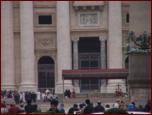
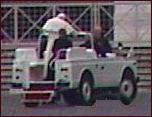 Then we saw the popemobile driving up the steps of the Basilica, His Holiness visible in his perch. This was exciting and unexpected - we get to see the Pope. TRIVIA: the popemobiles on the papal number plate are "SCV1", Stato della Citta del Vaticano (Vatican City State), but many Romans take them as an acronym for "Se Cristo Vedesse" - if only Christ could see this.
Then we saw the popemobile driving up the steps of the Basilica, His Holiness visible in his perch. This was exciting and unexpected - we get to see the Pope. TRIVIA: the popemobiles on the papal number plate are "SCV1", Stato della Citta del Vaticano (Vatican City State), but many Romans take them as an acronym for "Se Cristo Vedesse" - if only Christ could see this.
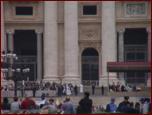 The popemobile continued along the front of the Basilica, stopping behind the covered stage. There the 79-year-old pontiff disembarked - with the assistance of black-robed clergy and the more colorfully-outfitted Swiss Guard - and made his way to the stage.
The popemobile continued along the front of the Basilica, stopping behind the covered stage. There the 79-year-old pontiff disembarked - with the assistance of black-robed clergy and the more colorfully-outfitted Swiss Guard - and made his way to the stage.
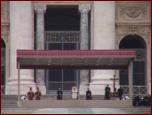 There Il Papa began a dance of tongue, with an assistant announcing visiting groups in their native language and the pontiff giving a greeting in that same language. The Japanese delegation produced small Kyo Maru (rising sun) flags, the Texans jumped up and cheered for themselves, etc. His greeting is scripted; I was able to compare the English and German versions.
There Il Papa began a dance of tongue, with an assistant announcing visiting groups in their native language and the pontiff giving a greeting in that same language. The Japanese delegation produced small Kyo Maru (rising sun) flags, the Texans jumped up and cheered for themselves, etc. His greeting is scripted; I was able to compare the English and German versions.
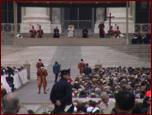 Access to the pontiff is amazingly open, given his history and his state of health. One can get quite close to Il Papa and get some good views of him. The blue-clad Italian Carabineri and the brown-clad Swiss Guard keep a watchful eye on the audience, but there's not much feeling of restrictive security. If there are snipers in the colonnade there's no clue. (I've felt more uncomfortable around San Francisco Mayor Willie Brown's security detail.)
Access to the pontiff is amazingly open, given his history and his state of health. One can get quite close to Il Papa and get some good views of him. The blue-clad Italian Carabineri and the brown-clad Swiss Guard keep a watchful eye on the audience, but there's not much feeling of restrictive security. If there are snipers in the colonnade there's no clue. (I've felt more uncomfortable around San Francisco Mayor Willie Brown's security detail.)
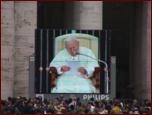 Here you see the pontiff being shown in the giant televisions. We had a pretty clear view, but if you have failing eyesight or the poor luck to have your view obstructed by the obelisk or a tall person in front of you this might be an acceptable alternative.
Here you see the pontiff being shown in the giant televisions. We had a pretty clear view, but if you have failing eyesight or the poor luck to have your view obstructed by the obelisk or a tall person in front of you this might be an acceptable alternative.
We stayed behind the third set of barricades, past the two sections of chairs, so that Isaac could run around at his pleasure. Rose and I got a good view of the goings-on while Cicki and Isaac ranged far and wide.
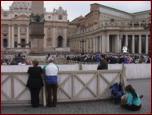
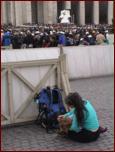 The weather was great, and we tarried for quite a while. It was fun hearing all the difficult languages and watching the reactions of the groups. We heard that His Holiness does this every Wednesday and Saturday (or was it Sunday?). What a grueling schedule. Isaac grew tired of all the running around, chasing pigeons and pilgrims, and so he came over to Rose for a snack. When he was done we continued on our way, heading out to the Museo Vaticani.
The weather was great, and we tarried for quite a while. It was fun hearing all the difficult languages and watching the reactions of the groups. We heard that His Holiness does this every Wednesday and Saturday (or was it Sunday?). What a grueling schedule. Isaac grew tired of all the running around, chasing pigeons and pilgrims, and so he came over to Rose for a snack. When he was done we continued on our way, heading out to the Museo Vaticani.
|
 subscribe
subscribe
 subscribe
subscribe



 Then we saw the popemobile driving up the steps of the Basilica, His Holiness visible in his perch. This was exciting and unexpected - we get to see the Pope. TRIVIA: the popemobiles on the papal number plate are "SCV1", Stato della Citta del Vaticano (Vatican City State), but many Romans take them as an acronym for "Se Cristo Vedesse" - if only Christ could see this.
Then we saw the popemobile driving up the steps of the Basilica, His Holiness visible in his perch. This was exciting and unexpected - we get to see the Pope. TRIVIA: the popemobiles on the papal number plate are "SCV1", Stato della Citta del Vaticano (Vatican City State), but many Romans take them as an acronym for "Se Cristo Vedesse" - if only Christ could see this. The popemobile continued along the front of the Basilica, stopping behind the covered stage. There the 79-year-old pontiff disembarked - with the assistance of black-robed clergy and the more colorfully-outfitted Swiss Guard - and made his way to the stage.
The popemobile continued along the front of the Basilica, stopping behind the covered stage. There the 79-year-old pontiff disembarked - with the assistance of black-robed clergy and the more colorfully-outfitted Swiss Guard - and made his way to the stage. There Il Papa began a dance of tongue, with an assistant announcing visiting groups in their native language and the pontiff giving a greeting in that same language. The Japanese delegation produced small Kyo Maru (rising sun) flags, the Texans jumped up and cheered for themselves, etc. His greeting is scripted; I was able to compare the English and German versions.
There Il Papa began a dance of tongue, with an assistant announcing visiting groups in their native language and the pontiff giving a greeting in that same language. The Japanese delegation produced small Kyo Maru (rising sun) flags, the Texans jumped up and cheered for themselves, etc. His greeting is scripted; I was able to compare the English and German versions. Access to the pontiff is amazingly open, given his history and his state of health. One can get quite close to Il Papa and get some good views of him. The blue-clad Italian Carabineri and the brown-clad Swiss Guard keep a watchful eye on the audience, but there's not much feeling of restrictive security. If there are snipers in the colonnade there's no clue. (I've felt more uncomfortable around San Francisco Mayor Willie Brown's security detail.)
Access to the pontiff is amazingly open, given his history and his state of health. One can get quite close to Il Papa and get some good views of him. The blue-clad Italian Carabineri and the brown-clad Swiss Guard keep a watchful eye on the audience, but there's not much feeling of restrictive security. If there are snipers in the colonnade there's no clue. (I've felt more uncomfortable around San Francisco Mayor Willie Brown's security detail.) Here you see the pontiff being shown in the giant televisions. We had a pretty clear view, but if you have failing eyesight or the poor luck to have your view obstructed by the obelisk or a tall person in front of you this might be an acceptable alternative.
Here you see the pontiff being shown in the giant televisions. We had a pretty clear view, but if you have failing eyesight or the poor luck to have your view obstructed by the obelisk or a tall person in front of you this might be an acceptable alternative.
 The weather was great, and we tarried for quite a while. It was fun hearing all the difficult languages and watching the reactions of the groups. We heard that His Holiness does this every Wednesday and Saturday (or was it Sunday?). What a grueling schedule. Isaac grew tired of all the running around, chasing pigeons and pilgrims, and so he came over to Rose for a snack. When he was done we continued on our way, heading out to the Museo Vaticani.
The weather was great, and we tarried for quite a while. It was fun hearing all the difficult languages and watching the reactions of the groups. We heard that His Holiness does this every Wednesday and Saturday (or was it Sunday?). What a grueling schedule. Isaac grew tired of all the running around, chasing pigeons and pilgrims, and so he came over to Rose for a snack. When he was done we continued on our way, heading out to the Museo Vaticani.